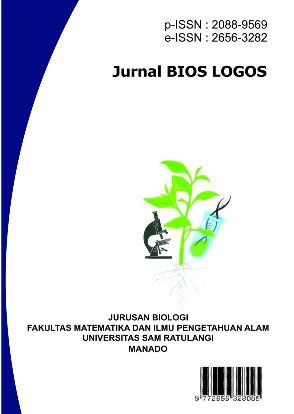Organoleptic Test of Salam Leaves (Syzygium polyanthum) as an Herbal Drink with the Addition of Moringa Leaves (Moringa oleifera L.)
DOI:
https://doi.org/10.35799/jbl.v14i1.54689Keywords:
Bay Lea, Moringa, Antioxidant Content, Flavanoid Content, Organoleptic TestAbstract
Tea is a fresh drink made from processed tea leaves. Bay leaves and Moringa leaves are used as the main ingredients in making this tea. Syzygium polyanthum and Moringa oleifera L. plants contain the same compounds, namely flavonoids and have anti-inflammatory properties. The purpose of this study was to measure antioxidant and flavonoid levels in the making of bay leaf tea with the addition of Moringa leaves, as well as conduct organoleptic tests in Kampung Dalam Village. This research method is experimental with quantitative data analysis, using four formulations in antioxidant and flavonoid tests, namely 80%: 20%, 70%: 30%, 60%: 40%, and 50%: 50%, as well as survey method with quantitative data analysis for organoleptic properties test. The results showed that the highest antioxidant and flavonoid levels were found in the 80:20% formulation, which were 13.22 ppm and 42.7500 mQE/g. The organoleptic assessment results showed that the 50%:50% formulation had the highest level of liking at 75% with a neutral description. In addition, the 70%:30% formulation has the highest aroma level of 77.5% with a scented description, the 50%:50% formulation has the highest taste level of 70% with a tasteless description, and the 50%:50% formulation has the highest color level of 67.5% with a yellowish green description. The conclusion is that the addition of moringa leaves as an herbal drink to bay leaves has a significant effect on liking, aroma, taste and color
References
Anjarsari, D. (2016). Katekin Teh Indonesia: Prospek dan Manfaatnya. Jurnal Kultivasi Vol 15 (2): 99-106.
Anwariyah, S. (2014). Kandungan Fenol Komponen Fitokimia dan Aktivitas Antioksidan Lamun Cymodocea Rotundata. Skripsi. Departemen Teknologi Hasil Perairan Fakultas Perikanan dan Ilmu Kelautan Institut Pertanian Bogor.
Chotimah, Chusnul. (2019). Uji Total Flavanoid dan Aktivitas Antioksidan Ekstrak daun dan Kulit Batang Dadap Serep (Erythryna subumbrans (Hassk Merr.) Menggunakan Pelarut yang Berbeda. Skripi. Universitas Islam Negeri Maulana Malik Ibrahim. Malang.
Eukarine, O.L., Oke O.V., dan Ajiboye A.J. (2014). Nutritional Equalitiesand Phytochemical Constituents of Clerodendum Volubile a Tropical Nonconventinal Vegetable. International Food Journal. 18(4).
Gandjar, I G., dan Rohman, A. 2(016). Analisis Obat Secara Spektrofotmetri dan Kormatografi. Pustaka Belajar: Yogyakarta.
Harismah, Kun dan Chusniatun. (2016). Pemanfaatan Daun Salam (Syzygium polyanthum) Sebagai Obat Herbal dan Rempah Penyedap Makanan. Jurnal Jurusan Teknik Kimia. Vol 19 (2) ISSN1410-9344.
Irianti, T., Murti, Y.B Kanistri, D.N., Pratiwi, D.R., Kuswandi dan Kusumaningtyas. (2016). DPPH Radical Scavening Activity Of Aquaeous Fraction From Ethaholic Extract Of Talok Fruit (Montingia Calabura). Tradisional Medicine Journal. 16 (2).
Kiptiah, M., Nina Hairiyah., Ade Setia Rahman. (2020). Proses Pembuatan Teh Daun Salam (Syzygium polyanthum) Dengan Perbandingan Daun Salam Muda dan Daun Salam Tua. Jurnal Teknologi Agro Industry. Vol 7 (2) ISSN 2598-5884.
Luthfiyah, F. (2015). Potensi Gizi Daun Kelor (Moringa oleifera). Media Bina Ilmiah. Nusa Tenggara Barat.
Molyneux, P. (2015). The use of the stable free radical diphenylpicrylhydrazyl (DPPH) for Estimasting Antioxidant Activity. Original Article. Sangklanarin : Pillar physics.
Prio, R.I (2016). Fruit and Vegetable in the Prevention of Cellular Oxidative Damage. Am. J. Clin. Nutr 78 (1).
Purba, Risaluna Arianda dan M. Idris. (2023). Ulization of Coconut coir and Guava Leaves for The Natural Preservation of Palm Sugar. Jurnal Biologi Tropis. 23(1) : 147-154.
Rahmawati, N. (2015). Aktivitas Antioksidan Total Fenol Teh Herbal Daun Pacar Air (Impatiens balsamina) Dengan Variasi Lama Fermentasi dan Metode Pengeringan. Skripsi. Universitas Muhammadiyah Surakarta.
Rampengan, V. J. (1985). Dasar-Dasar Pengawasan Mutu Pangan. Badan Kerja Sama Perguruan Tinggi Negeri Indonesia Bagian Timur Ujung Pandang.
Sani. (2018). Metode Penelitian Farmasi Komunitas dan Eksperimen. CV Budi Utama: Yogyakarta.
Sie, Jessica Oeinitan. (2015). Daya Antioksidan Ekstrak Etanol Kulit Buah Manggis (Garcinia mangostana Linn) Hasil Pengadukan dan Reflux. Jurnal Ilmiah Mahasiswa Universitas Surabaya. Vol 2 No 1.
Subekti, T. (2018). Aktivitas Antioksidan Teh Celup Kombinasi Daun Kelor dan Daun Salam. Skripsi Penelitian. Universitas Widya Dharma Klaten.
Sugiyono. (2018). Memahami Penelitian Kualitatif. Alfabeta: Bandung.
Verdiana et al., (2018). Pengaruh Jenis Pelarut Pada Ekstraksi Menggunakan Gelombang Ultrasonik Terhadap Aktivitas Antioksidan Ekstrak Kulit Buah Lemon (Citrus Limon (Linn) Burm F). Jurnal Ilmu dan Teknologi Pangan, 7 (4), 213-222.
Yulia, Ir. M Idris MP., Rahmadina, M.Pd. (2022). Skrining Fitokimia Dan Penentuan Kadar Flavonoid Daun Kelor (Moringa Oeifera L.Desa Dolok Sinumbah Dan Raja Maligas Kecamatan Hutabaya Raya. Jurnal Biologi Universitas Islam Negeri Sumatera Utara.
Downloads
Published
How to Cite
Issue
Section
License
Copyright (c) 2024 Kirana Pebriana, M. Idris, Rahmadina

This work is licensed under a Creative Commons Attribution 4.0 International License.










